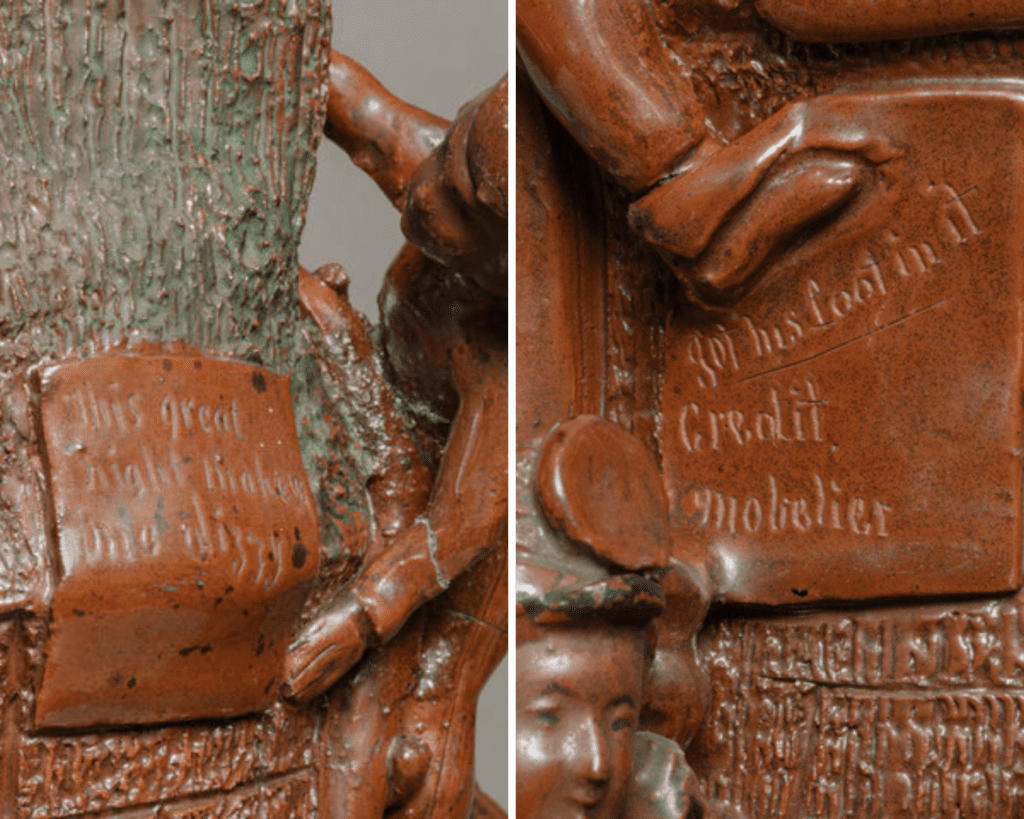
Liberty Monument by Cornwall Kirkpatrick and Wallace Kirkpatrick, Anna Pottery, Anna, Illinois, 1873. Museum purchase 2021.0017
The years after the Civil War were rife with violence and unrest as the country grappled with reunification and creating an equitable society. During the Reconstruction era, the political participation and social status of many Black Americans increased, while domestic-terrorist groups such as the Ku Klux Klan fought to keep white-supremacist policies in place. The bitter resentments of former slave owners and their struggles to retain power erupted in fighting throughout the South, notably in Louisiana in 1873.
The Anna Pottery “Liberty Monument,” on view in the Bearing Witness exhibition in the Galleries, tells the story of the especially violent event that occurred on April 13 of that year. Known as the Colfax Massacre, it is among the worst examples of the systemic brutality perpetrated by white supremacist terrorist groups on Black Americans in U.S. history. What led up to this tragedy?
It stemmed from the 1872 governor election in Louisiana, which had resulted in a split vote between the Democrat and Republican candidates. When President Ulysses S. Grant sent federal military support to support the Republican Reconstructionist candidate, white Southerners retaliated. They created the “White League,” a heavily armed paramilitary group that intimidated Black and white Reconstructionists across the state. Out of fear that the White League would seize control of the local government, an all-Black militia took control of the courthouse in April 1873. A mob of 150 white men, including former Confederate soldiers and members of the Ku Klux Klan and the White League, stormed the courthouse and fired a cannon on the group inside. The two forces fought until the Black militia was forced to surrender. The group of white men then murdered most of the Black men. Historians estimate that between 60 and 150 Black Americans were killed that day.
Wallace and Cornwall Kirkpatrick, the potters who made the Liberty Monument in 1873, clearly had a visceral reaction to hearing news about the event. Atop the monument stands Lady Liberty, who ironically watches a violent instance of voter suppression. Inscriptions on the surface state, “Our protection / under the / Civil-right / Bill,” a reference to the Civil Rights Act of 1866 that provided U.S. citizens of all races equal protection under the law. The words “Freedom / in / Louisiana” sarcastically point out the government corruption and social inequity that contributed to the devastation in Colfax.

The Kirkpatricks also included a depiction of Grant’s vice president, Schuyler Colfax. Although not directly involved with the massacre, Colfax was associated with government corruption, having been implicated in the Crédit Mobilier scandal. The inscriptions “this great / hight makes / me dizzy” and “got his foot in it / Credit Mobelier” appear near Colfax.

The Colfax Massacre is often left out of history books, even though it fundamentally affected racial relations and altered the fabric of not only Louisiana but the country as a whole. On its 150th anniversary, we remember the single most violent instance of racial violence during the Reconstruction Era, which laid the foundation for segregation in the United States.
Read more and see the Anna Pottery “Liberty Monument” on view in the Bearing Witness exhibition in the Galleries, and watch a video narrated by Jonathan Michael Square.